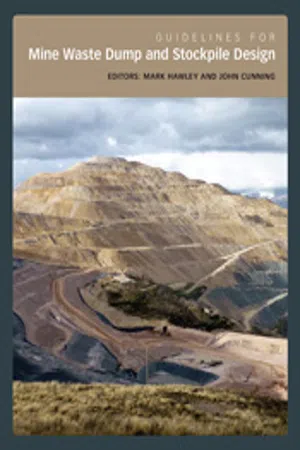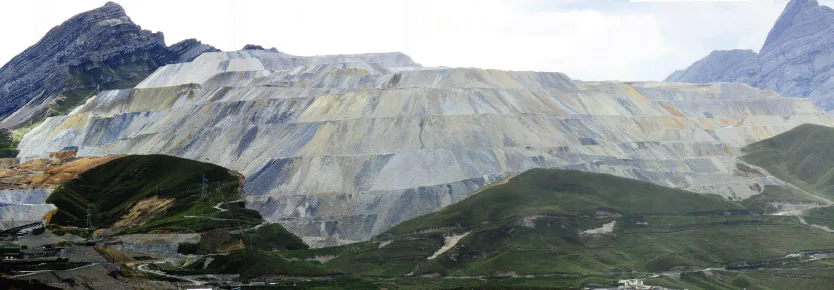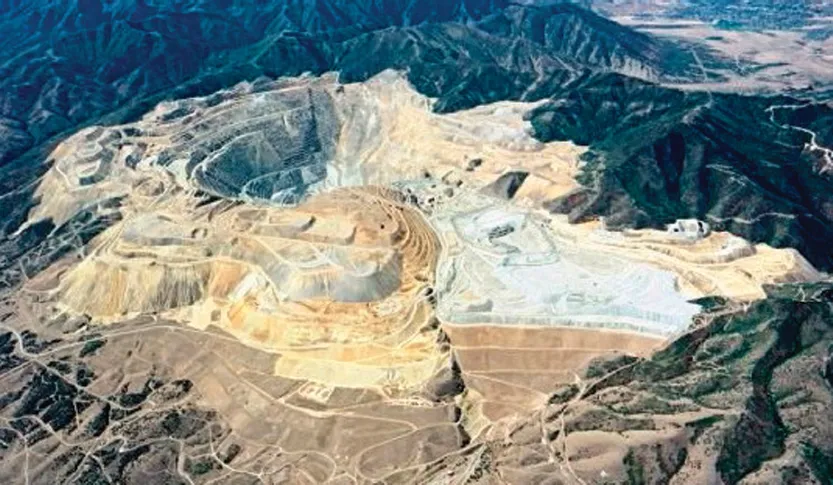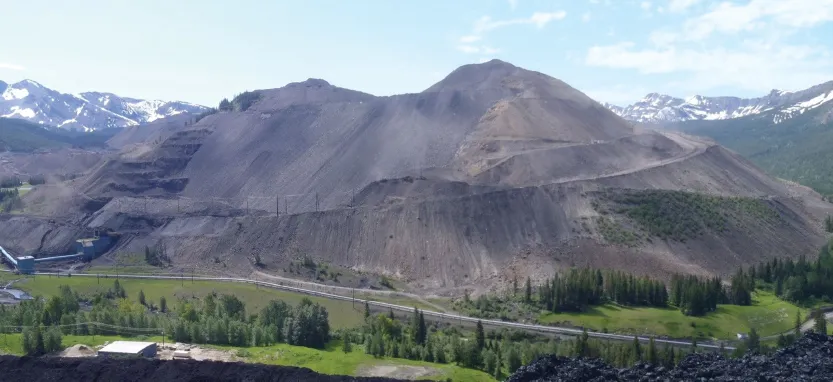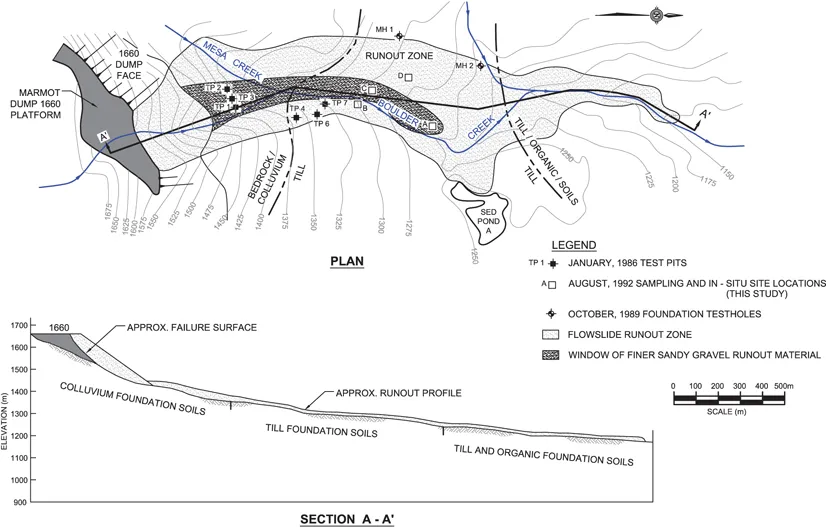![]()
1
INTRODUCTION
Mark Hawley and John Cunning
1.1 General
In terms of both volume and mass, waste dumps associated with large open pit mines are arguably the largest man-made structures on Earth. Their footprints typically exceed the aerial extent and their heights often rival the depths of the open pits from which the material used to construct them is derived.
Figure 1.1 is a view of the East Dump at the Antamina Mine in Peru. This dump contains ~1 billion tonnes of material, covers an area of 240 ha, and has an overall height of more than 500 m. Figure 1.2 is a view of the waste dumps at Rio Tinto Kennecott’s Bingham Canyon Mine in Utah, USA. This mine has a long development history spanning more than 100 years. The original dumps were constructed using rail haulage and tips, with subsequent expansions using truck haulage. Figure 1.3 is a view of a waste dump at a coal mine in the Elk Valley region of British Columbia, Canada. A cumulative volume of waste rock of over 8.5 billion tonnes with overall dump heights of up to 400 m have been deposited in the Elk Valley area coal mines over ~45 years.
While most waste dumps worldwide have performed very well, there are many cases where they have been subject to large-scale instabilities with significant adverse consequences. Figure 1.4 illustrates one such failure that occurred in 1987 at the Quintette Coal Mine in British Columbia, Canada. This failure involved more than 5.6 million m3 of material, and the runout distance exceeded 2 km (for additional details on this failure see BCMEM record #60 in Appendix 1).
Despite these metrics, the amount of effort expended on the investigation, design, implementation and monitoring of these massive structures is often small in comparison to the programs for their source open pits. Likewise, our understanding of their behaviour and our ability to model and reliably predict their stability is not as advanced as for open pit slopes and other large earth structures, such as tailings impoundments and water retention dams, and their design remains largely empirical.
Figure 1.1: East Dump at the Antamina Mine, Peru, ca. 2010. Source: M Hawley. Published with the permission of Compañia Minera Antamina S.A.
Figure 1.2: View of the Bingham Canyon Mine and associated waste dumps, ca. 2010. Source: Rio Tinto Kennecott Copper
Figure 1.3: View of waste dumps at a mine in the Elk Valley region of British Columbia. Note backfill waste dumps (active) in centre and reclaimed (inactive) waste dumps on right. Source: J Cunning
1.2 Historical context
Some of the earliest work on developing a formal understanding of the mechanics of mine waste dumps was conducted in the early 1970s in response to the failure of a coal mine waste tip in Wales in 1966 (Fig. 1.5). Runout from this failure inundated a primary school and residential section in the town of Aberfan, killing 116 children and 28 adults. The failure was attributed to a build-up of pore pressure in the waste material due to heavy rains and natural springs in the foundation which triggered a liquefaction-type failure.
Figure 1.4: Plan and profile showing the failure of the Quintette 1660 WN Waste Dump in 1987. Source: After CANMET (1994). © Her Majesty the Queen of Canada, as represented by the Minister of Natural Resources, 2015
In 1975, the US Mining Enforcement and Safety Administration (MESA 1975) (predecessor to the current US Mine Safety and Health Administration) published a design manual for coal refuse disposal facilities. This manual was intended to provide guidelines and standards for open strip coal mine waste dumps being developed predominantly in the eastern United States (Virginia and Kentucky), and the design methodologies were based largely on classical soil mechanics approaches. The MESA manual was followed in 1977 by the Pit Slope Manual, published by the Canadian Centre for Mining and Metallurgy (CANMET 1977), which incorporated a chapter on waste embankments that included both tailings dams and waste rock dumps. In 1982, the US Bureau of Mines (USBM) published a comprehensive reference on the Development of Systematic Waste Disposal Plans for Metal and Nonmetal Mines (USBM 1982), and in 1985 the Society for Mining and Metallurgy (SME) sponsored what appears to be the first focused workshop on the Design of Non-impounding Waste Dumps (SME 1985). In 1989, the US Department of the Interior’s Office of Surface Mining published a new manual for the design and closure of spoils from surface coal mines (OSM 1989), replacing the earlier MESA manual. In 1991, as a follow-up to legislative changes flowing from the Aberfan disaster, the government of the United Kingdom published a Handbook on the Design of Tips and Related Structures (Geoffrey Walton Practice and Great Britain, Department of the Environment 1991).
In 1990, in response to a series of large waste dump failures at metallurgical coal mines in the Canadian Rocky Mountains, a committee composed of local mining companies, the Canadian Centre for Mineral and Energy Technology (CANMET) and the British Columbia Ministries of Environment and Energy, Mines and Resources (the British Columbia Mine Waste Rock Pile Research Committee [BCMWRPRC]) was formed to foster research on mine waste dumps. The outcome of this research included a series of interim guidelines and focused research reports, which are summarised in Table 1.1.
Figure 1.5: Aberfan coal tip failure, 21 October 1966. Source: M Jones and I McLean (n.d.) The Aberfan Disaster. <http://www.nuffield.ox.ac.uk/politics/aberfan/home2.htm>
While this work was based primarily on experience with large waste rock dumps associated with the surface metallurgical coal mines located in mountainous terrain in British Columbia and Alberta, Canada, the Interim Guidelines (reports #1 and #2 in Table 1.1) were generalised to include similar structures at other types of open pit mines. Following release of the Interim Guidelines, the BCMWRPRC sponsored a series of workshops throughout British Columbia that were intended to introduce the concepts and proposed classification and design methodologies and to solicit feedback from industry. After an introductory period, it was intended to update the Interim Guidelines and publish final versions. Unfortunately, the BCMWRPRC was unable to secure funding for this phase of the program, and the Interim Guidelines were never finalised. Nevertheless, they continue to be used as a practical reference by many practitioners and some regulators.
Since the mid-1990s there have been many individual contributions to the literature on waste rock dumps, including papers describing advances in site investigation and materials testing, new analysis techniques and computer software codes, and case studies. In the Slope Stability 2000 conference sponsored by the SME in Denver, USA (Hustrulid et al. 2000), one session was dedicated to waste rock dumps, and in 2008 the Australian Centre for Geomechanics (ACG 2008) sponsored the First International Seminar on the Management of Rock Dumps, Stockpiles and Heap Leach Pads in Perth, Australia. In 2009 a second edition of the 1975 Engineering and Design Manual – Coal Refuse Disposal Facilities (MSHA 2009) was published. Several dedicated workshops, online courses and sessions associated with various conferences and symposia have also been held over the last several years.
Another good source for papers on mine waste dumps is the proceedings of the Tailings and Mine Waste Conference, which has been held annually in Fort Collins or Vail, Colorado, USA, Vancouver BC, Canada or Banff Alberta, Canada between 1994 and 2004, and between 2007 and 2016.
Table 1.1: Summary of BCMWRPRC and CANMET waste dump interim guidelines and related research reports
| Report # | Report title | Date issued | Prepared by | Reference |
| 1 | Investigation and Design Manual, Interim Guidelines | May 1991 | Piteau Associates Engineering Ltd | BCMWRPRC (1991a) |
| 2 | Operating and Monitoring Manual, Interim Guidelines | May 1991 | Klohn Leonoff Ltd | BCMWRPRC (1991b) |
| 3 | Review and Evaluation of Failures, Interim Report | March 1992 | Scott Broughton | BCMWRPRC (1992a) |
| 4 | Runout Characteristics of Debris from Dump Failures in Mountainous Terrain Stage 1 Data Collection Volume I Text and Tables
Volume II Drawings ... |
